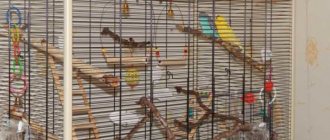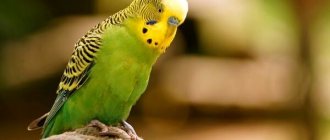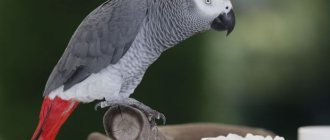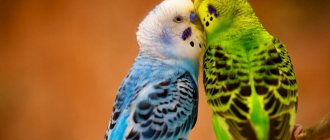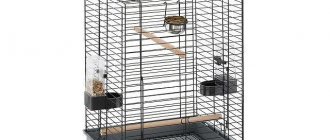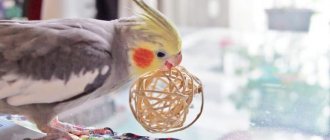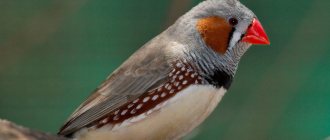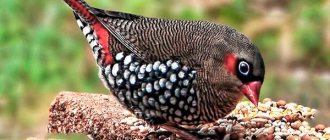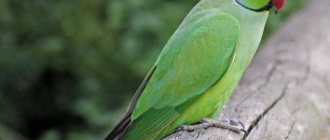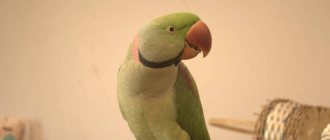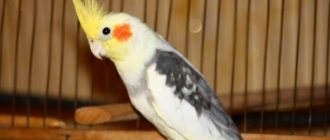Budgerigars are successfully kept at home - beautiful birds with a peaceful and curious character. They get along well with people and do not feel much discomfort in captivity, but for this it is necessary to create appropriate conditions for their life.
When purchasing a parrot for your home, you should immediately buy a cage for it, where it will spend a significant part of its time. The choice of this accessory should be taken with full responsibility, since the health and lifespan of your feathered friend depend on the conditions of detention.
In the article we will tell you what a cage for a budgie should be like, the optimal design, dimensions, material, what a budgie needs in a cage, mandatory items and additional accessories for organizing the space, where it is best to place the cage with a parrot, whether it needs to be covered with a cloth at night .
Choosing an aviary
When you decide to have birds, you should take care of their comfortable stay. After all, birds like space and freedom, and because... the bird will live in a cage, then it needs to be provided with a large and durable aviary. Manufacturers have developed a large number of aviaries for birds. Square, round, metal, wood, twigs.
Size and shape
When choosing a cage, the owner should choose a huge, spacious, strong one, and one that is not dark in it. Pernatics are cowardly birds; to be comfortable, they need a lot of sunlight. By choosing a spacious enclosure for your pet, the owner will provide the pet with maximum freedom. And also if you have other pets, the wavy will not become prey for her.
Good materials from which an aviary can be made are:
- copper;
- tree;
- stainless steel.
Manufacturers often paint the enclosure with a zinc mixture. You shouldn’t buy these, because during peeling your pet can chew it off. This will have a bad effect on his health and lead to poisoning.
The wooden cage is popular among owners. It is harmless and will not cause chemical poisoning to the bird. However, a wooden enclosure should be chosen only from certain trees: willow, maple, birch, linden.
Arrangement
The owner cannot do it simply by purchasing a cage. It must contain the necessary accessories.
Aviary pallet
If the aviary has a grate at the bottom, then it should be removed, because the bird may injure its paws. Fillers are also not needed; you can lay down paper towels, but not newspaper, because the paint on it is toxic.
Perches
It is better to give preference to natural perches with bark. Having 2 or 3 perches is suitable; they should be of different diameters so that the pet’s paws do not get tired. Tree branches will also work.
Feeders
Manufacturers advise purchasing several feeders: for grain, porridge, fruit.
Drinking bowls
There are 2 types of drinking bowls: open and closed. The advantage of a closed drinking bowl is that debris cannot get into it, but this type of drinking bowl is inaccessible to birds. On the contrary, open drinking bowls are good in everything except one thing: garbage constantly gets into them. Therefore, it is worth hanging it in a place that is difficult to reach for garbage.
Sepia/mineral stone
Another necessary thing for a budgerigar is sepia. The bird sharpens its beak on it and receives calcium and minerals. But there is one important point: manufacturers suggest attaching a mineral pebble to a piece of iron, this is not suitable, because... the bird may be injured at the point of the beak. The stone should be tied to a string or attached with a clothespin. An important point: you cannot tie it with a thread, because the bird will clog its goiter.
Toys
To prevent your pet from getting bored, he should hang several toys. Just a little so that the chick can move freely around the cage.
Accommodation
The location of the enclosure depends on the construction of your house. The cage should be placed in a bright place with sunlight, because they are important for the pet's life. You cannot place it on a windowsill near a window. Due to its broad outlook, a bird may see something scary for it in the window, for example, a crow, and get scared. This can lead to stress or death of the bird, because they are very shy.
In winter, there is no need to place the enclosure near the battery. Due to the plumage, as well as the heat from the battery, the bird will be hot. Also, the enclosure should be at eye level of the owner, not on the floor, because walking by all family members will scare the pet. One side of the enclosure is near the wall so that the pet feels safe.
It is advised to choose a neutral room to stay in, where there is no fuss, but only silence.
Temperature
Having taken the bird home, the owner must ensure a comfortable stay, just like in the tropics. The room should be warm and lit. There should be no fluctuations in temperature. Overheating of the wavy can lead to sunstroke, and drafts can lead to illness in your pet. The optimal air temperature in the room is +18-22°C. There is a lot of moisture in the tropical jungle, so for good plumage and shine on the feathers it is worth purchasing a humidifier.
Purity
General cleaning of your pets' cage should be done 1-2 times a month. While the owner is doing this, the parrots can be allowed to fly around the apartment. This way they can stretch their wings and feel a breath of freedom. Before washing the enclosure, you need to remove all the accessories, water bowl, feeder and perches, wash the tray and wipe the bars.
Toys should also be sprayed with a spray bottle until completely dry. If the owner has washed the entire enclosure with detergent or powder, it is worth rinsing it thoroughly with water so that the bird is not poisoned by chemicals.
It is better to clean the tray with an unnecessary toothbrush, because... a metal sponge will scratch the plastic, and in the future dirt will get clogged there.
The bird flew away. Dangers for a flying away bird.
If your bird flew out of a window, out of an aviary or on a walk, then the chances of returning it depend on how prepared your bird was for such a turn of events - i.e. what physical shape she was in before departure. If your bird has spent most of its life in a cramped cage, then once outside it will have little chance of avoiding trivial dangers (cars, dogs, crows, birds of prey). This is another reason to exercise with your birds. Master tricks, commands and free flights. Even if noticeable success in mastering free flights is not immediately visible, this will improve the bird’s physical fitness.
Diet
Budgerigars have a varied diet. A balanced complex of nutrients and active substances will help you be completely healthy. Birds should be fed with special food from a pet store, but first the owner can consult with an ornithologist to choose a suitable grain mixture.
In addition to grain, birds should be given vitamins, which they can get from vegetables, fruits, cereals, herbs and nuts. Also, the bird’s body must receive macro and microelements, which should be given separately from complementary foods.
Food and vitamins should be consumed by your pet in certain doses. The grain mixture needs 2 tbsp. per day, as well as water and fruit.
Prohibited Products
Everything that the owner eats will not suit the budgerigar’s diet. You should absolutely not give them caffeine, alcohol or cocoa. This is deadly for the life of the pet. You should also not give baked goods, because the yeast will swell inside the stomach and cause gastrointestinal upset. In addition to these foods, pets should not eat fried, sweet or spicy foods. You can replace all this with a boiled chicken egg, just cook without adding salt.
If the owner decides to pamper the pet with berries or fruits containing a seed, then it must be removed, because... under the influence of moisture, hydrocyanic acid is formed, the consumption of which will also cause food poisoning.
It is also not recommended to give twigs of cherries or cherries, as the bird may choke.
Favorite Products
Budgerigars are not picky eaters, so you can give them what you like. Fruits and vegetables containing vitamins A and B, as well as boiled nuts and cereals. Budgerigars love to crunch, so the owner can safely eat an apple, carrots, cabbage and crackers made from whole grain bran without salt.
What dangers does your bird face outdoors?
hunger cold predatory animals cars people
Hunger.
If the bird flies away in the warm season, when there is a lot of greenery and natural food for birds, hunger will not threaten either the canary, the budgie, or even the large and medium-sized parrots. These birds will easily find food for themselves.
Parrots will eat leaves, shoots, thin branches, berries, fruits and nuts of varying degrees of maturity, pine needles and pine cones. Even just in a birch grove they will not starve.
Here is a red-tailed gray gray (Psittacus erithacus erithacus) feeding on chestnut inflorescences and eating horse chestnut flowers. For several days this parrot was observed in Moscow feeding on flowering chestnut trees and unripe apples.
And in the second half of summer and autumn - grays, cockatoos, macaws, Amazons, karellas, necklace parrots - have even more food available. Small parrots also easily switch to feeding on twig food, leaves, inflorescences, fruits and berries.
In addition, budgerigars, parakeets, and lovebirds quickly attach themselves to flocks of sparrows and feed on bird feeders. Pale parrots do not face hunger at any time of the year - they eat literally everything and quickly settle into flocks of passerines, pigeons, and jackdaws.
Forest songbirds, even after living in cages for years, have a chance to survive if they fly away in the warm season, it all depends on their physical form - the more often these birds flew around the room, the better condition they will be when they find themselves in nature again. Food for such birds is most often available, natural instincts and reflexes are preserved.
This is not a recommendation to immediately release songbirds purchased at a bird market, nor is it an excuse for the tradition of “releasing birds” at weddings or holidays. This is a statement of fact; such birds have a chance to survive, especially if the birds were in good physical shape before. This is the main difference between such birds and birds from the market.
Communication and training
Many people believe that large parrots, such as Macaws, Jacos, and Cockatoos, are “talking” birds, but this is not true. Wavys are also able to repeat words and insert them where needed, imitating an intelligent bird. It is very easy to teach a parrot to talk using some effective methods.
From birth, being among their own, the chicks imitate older parrots and learn to produce certain sound signals. When they are in captivity, they begin to repeat after those they see and hear, that is, to all family members.
4 essential principles for teaching a parrot to talk:
- Frequent classes. If the owner quickly decided to do this, then it is worth saying the same words regularly and every day. Since this activity is tiring, all family members can record individual words on a voice recorder and play it again.
- Insulation. This method is suitable for those who have not one, but several parrots. Because birds like to chirp among themselves, this can distract them from human speech, so isolate other parrots for a while.
- No anxiety. Before you start training with a bird, you need to understand whether it is alarmed. If everything is fine and she has adapted at home, then you can start.
- Prizes. Any pet can follow the owner's commands for encouragement. If the bird says the word, let it eat the prize. Just don’t overdo it so that your pet doesn’t lose interest in the lessons. Children will also enjoy this activity; they will be willing to watch them.
Bird wing balcony on a regular balcony
Let's expand the vent theme even wider - you can use the entire vertical sash of the window facing the balcony as an aviary. The project is ideal for plastic windows and does not require drilling of profiles. Advantages:
The structure, as in the case of the vent version, is easiest to make from wood, but it must be much more durable - the process will take longer. It is convenient to attach to the window sill, external walls, the upper part of the window opening - it is better to leave the plastic profiles themselves intact; there is no need to drill them. The structure will consist of wooden beams and galvanized mesh - it has a small windage, but you yourself, spinning on the balcony, can touch the enclosure, a crow may (well, suddenly) crash into it... In short, do it conscientiously - so that it is one with the window sill and the wall . For greater aesthetics, you can try to insert the rods from the mesh directly into the wooden beam, cutting off the excess ones - it will be enough to use every fifth one. The outside of the parrot's enclosure can be painted white (or the color of your window profiles), but the inside is best left as bare wood - the birds will probably chew it, and the paint may be harmful to them.
At the bottom of the folding aviary you can place a bird garden, where pets can enjoy sprouted and grown food, or some separate crop, such as millet or wheat.
Just like in the window balcony, be sure to secure all places where wild birds may try to join your pets. Add some wire, punched tape, and spikes to the top of the enclosure. If the aviary occupies part of the windowsill, make sure that pigeons, sparrows, titmice and other uninvited guests cannot land there - then your birds will remain healthy.
Birds can freely enter and exit their balcony aviary, but a person with this decision should enter his balcony with caution so that pets do not fly out there. We recommend using thick tulle to the floor, and covering yourself with it when passing through the balcony door. If the birds want to follow you, they will very quickly understand that the easiest way is to use the window frame provided for them - the aviary.
Bathing
Budgerigars come from tropical rainforests and require careful care. There are special fountains where water gurgles, and the birds can bathe and cleanse themselves. You need to bathe the bird once a week. In summer you can 2-3 times a week if it is very hot.
Parrots love water, so if they want to swim, the owner will understand. For shy birds, you can pour water into a saucer and place it next to the cage. Let your pet become interested and take a bath.
If the wings get dirty with paint or other chemicals while flying around the apartment, you should trim them carefully.
How to teach a parrot to talk?
The parrot should be placed on a hand or play stand, or left in a cage on a crossbar. After you manage to attract your pet’s attention, repeat the desired phrase 10-20 times in a row. These should be phrases that you use frequently in your daily life. Speak them clearly and emotionally.
Interesting materials:
Who listens to what music? Who lost weight on the buckwheat diet? Who Carols at Christmas? Who controls the execution of a court decision? Who controls the board of directors? Who's the best person to find truffles? Who is the financially responsible person in the organization? Who migrates to Russia? Who is Mister P? Who can be an official?
Diseases and their prevention
The pet should be in a room where there are no drafts to avoid getting sick. However, there are also depressive illnesses that are more difficult to get rid of. This happens most often in those owners where the chick is alone. This has a bad effect on the bird’s condition, so it becomes aggressive and without communication can literally go crazy. To avoid this, simply communicate with your pet, watch how he lives and plays with toys. This way the bird will feel that it is not alone.
Previous
Vomiting, nausea and belching in a budgerigar
Next
Allergy to parrots
Where did we buy the mesh? Which one did you choose?
When Sindika was still alive, we went there to the burned-out construction market - inside there were various pavilions with mesh. Basically, rolled mesh with square cells was sold. Cheap, easy to work with - but the size of the cells was not ideal - a cockatiel could stick its head in there, a chick certainly. Although many people use such a mesh to build enclosures, we decided to use it as a cap for a balcony door to ensure summer ventilation. She's really easy to work with.
One of the sellers answered the question: “Is there something else more interesting?” He took us behind the market to the hangar of the metal warehouse - and here, yes - everything was much more interesting - we bought a roll of this kind of mesh, from which we built our own balcony enclosure. It was thicker, the cells were not square - and I regretted that I had not bought cooler nippers for it; my cheapest Leroys forced me to take long breaks after biting off the rods - my hand hurt.
